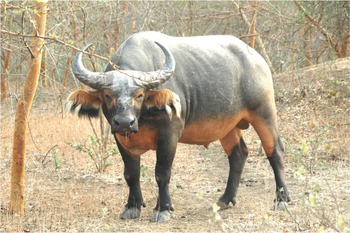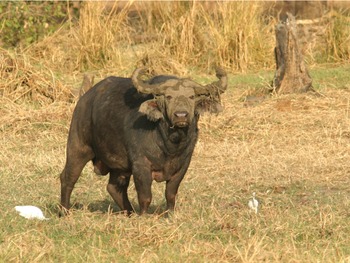The African buffalo is an emblematic species of African savannas and forests. It has figured in African cultures probably for millennia, and when people from the Middle East and Europe encountered African buffalo, it became the quintessential villain that could transform pampered men into heroes. Indeed, that Francis Macomber (as described by Ernest Hemmingway) had a short life after he stood his grounds when facing a charging buffalo is irrelevant; it was a happy life. Stories like these and other about ‘death in the long grass’ ensured the African buffalo’s place of honour on that champion rostrum of the Big Five. Indeed, these Big Five are considered the ‘worthy adversaries’ of our species – the African buffalo alongside the African elephant, lion, leopard and black rhinoceros. Animals of these five species were, according to hunters, valiant, dangerous, perilous, treacherous and mighty antagonists and thus embodied the ideal foes for the manly man, a category of humans into which, at that time, only grudgingly were dauntless women also admitted.
Besides its representations in African and Western cultures, the African buffalo is also a natural resource. It has provided a meat supply for human populations for thousands of years, and continues to do so today. The buffalo resource is also currently being exploited by safari tourism and trophy hunting. This blossoming tourism market in parts of Africa, mainly in southern Africa, has come up with new buffalo ‘products’ such as the lucrative commerce of disease-free buffalo or animals of high trophy quality. For reasons that are probably unfathomable, Westerners define ‘trophy quality’ in antelopes, deer and also buffalo by length and size of head appendages. In East Asia, neither form nor size of rhino horn is important for its aphrodisiac powers, and in African cultures, neither the size of the claws nor the whiteness of the fat of the large carnivores is of importance to explain its magical powers. Yet, in some African cultures the killing of an African buffalo as ‘enemy of the people’, especially when done alone and with a spear, is considered a feat of great significance, allowing for the willingness of women to share their love.
On a more mundane level, the African buffalo is of interest from a One Health perspective, because it is a maintenance host for many important pathogens that can trigger diseases mainly in domestic cattle: bovine tuberculosis, brucellosis and many others including tick-borne diseases such as theileriosis. This raises, and has been raising, concerns at buffalo/cattle/human interfaces all over Africa to the south of the Sahara. As a matter of fact, during the Colonial Era many ‘disease-free’ buffer zones were created by indiscriminately shooting and eradicating hundreds of thousands of large animals, including African buffalo. This red-line zoning continues even today in South Africa, Namibia, Botswana, Zimbabwe, Angola and Zambia.
Despite its importance in the African landscape and beyond, the species has not ‘benefited’ from many monographs looking at its ecology and management. Tony Sinclair published a book on this splendid beast with Chicago University Press some 45 years ago, and one of us did the same with Chapman & Hall (now Springer Nature) some 25 years ago. We are very grateful that Tony graced our present book with a Foreword because we consider him a true trailblazer for Nyatology, that is the Science of African Buffalo (‘Nyati’, like ‘Mbogo’, being the term for ‘African buffalo’ in kiSwahili). Since these monographs were published, much water has flowed through the Nile, the Congo and the Niger, and our knowledge has increased considerably. For example, the development of telemetry and remote-sensing techniques has greatly expanded our capacity to track wildlife individuals and social dynamics. For the past 15 years, we have been involved in telemetry studies on African buffalo (and other antelopes) in western and southern Africa. We have gathered one of the most extensive data sets available on the species (more than 200 GPS/satellite collars deployed). The field of genetics has also revolutionized species taxonomy and our understanding of population dynamics at the species and subpopulation levels. We have been involved in studies on the genetics of the African buffalo at the continent and regional levels. From a health ecology perspective, knowledge of the African buffalo’s role in the epidemiology of many African diseases, including zoonoses (pathogens that can spread form animal to humans), has also expanded considerably over the last few decades. Finally, the management and ranching of the species, especially in southern Africa, has evolved into a distinct zootechnical field.
We thus felt that there is a huge body of new knowledge with regards to the African buffalo and its interactions with other species, including domestic species and humans, which needed to be synthesized. We also had the opportunity to communicate extensively with other scholars and managers involved with this buffalo species through the AfBIG (African Buffalo Interest Group) under the umbrella of the IUCN SSC Antelope Specialist Group and two symposia that we organized, one in Paris (France: 2014) and one in Windhoek (Namibia: 2016). The cooperation and data sharing by the members of AfBIG that arose out of these gatherings and subsequent interactions through the Internet hugely contributed to the current volume.
The African buffalo represents a very special animal species that needs different management schemes across its range to maintain its populations ‘in a favourable conservation status’. Over much of its range, notably in East and southern Africa, its populations are still large and to some extent connected. There, the Cape buffalo can safely be hunted if done judiciously and with good knowledge of the population effects of hunting (Figure 0.1). Then and there, one may assume that the populations of East and southern Africa can be maintained in a favourable conservation status.

Figure 0.1 Cape African buffalo bull in front of a herd in Hwange National Park, Zimbabwe.
The situation with the northern savanna buffalo is much grimmer (Figures 0.2, 0.3 and 0.4). Most populations have been extirpated from their range between Senegal and Ethiopia even though there are still a handful of populations that maintain themselves due to conservation efforts by African governments sometimes supported by overseas’ organizations. However, while the historical range has shrunk in West and Central Africa, the populations in some of the few remaining strongholds have recently shown promising population increase, thus demonstrating that recovery of the northern savanna buffalo is possible if the political will and financial resources are available. Regulated hunting may perhaps again play a positive role in the conservation of those healthy populations. However, the recovery of former ranges and population rebound should have priority over much of the (former) distribution of the northern savanna buffalo.

Figure 0.2 West African savanna buffalo bull in Bandia reserve, Senegal.

Figure 0.3 West African savanna buffalo female and calf, W National Park, Niger.

Figure 0.4 Central African savanna buffalo bull, Zakouma National Park, Chad.
The third form of the African buffalo, the forest buffalo, occurs in two disjunct areas, one in the rainforest block to the west of the Dahomey Gap and the other in the Congo Basin rainforests to the east. Those western populations are nearly extinct now, while those living in the Congo Basin are still to some extent data-deficient. Yet a picture emerges that regulated and enforced conservation actions in timber, hunting and oil concessions may provide these buffalo with the only way to survive if the National Parks and other protected areas are no longer truly and effectively safeguarded. For this form of African buffalo, population recovery ought to be of main concern in the forests to the west of the Dahomey Gap. Nevertheless, regulated hunting could play a positive role for forest buffalo of the Congo Basin. However, this necessitates a better understanding of their fundamental ecology and population dynamics.
Because of these very different conservation statuses in the vast range of the species, the African buffalo provides that rare case in which strict conservation, hunting, interaction with livestock, genetic exchange and even breeding for trophies all deserve attention and up-to-date information. This is what we have been aiming for in the current book, for which we have brought together a multidisciplinary team of authors. We thus not only invited ecologists or purely academic geneticists to contribute to the knowledge of this unique species, but also veterinarians, wildlife managers, applied mathematicians, hunters and animal breeders. All these specialists we name ‘nyatiologists’ to emphasize what they have in common, namely, knowledge of buffalo, be it academic or/and experiential.
Of very few wild large mammal species their status in the tropics is still so favourable that sustainable use may contribute to their preservation. Yet, in other areas, primarily in the whole of West Africa, their status is now so much in peril that the knowledge about their sustainable use and management garnered in East and southern Africa largely should be used to recreate their former vast numbers. Indeed, sustainable use is only possible when the conservation status of a local population is favourable. We hope that the knowledge and experience reported in this book forms a useful foundation for restoring or maintaining the populations of this marvellous species throughout the whole of the African continent, and we dream of the African buffalo as a symbol of an African renaissance soon emerging from current global changes and social, ecological and political struggles.





